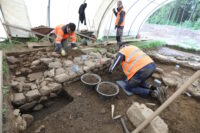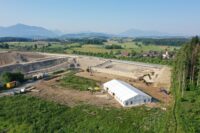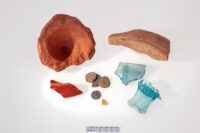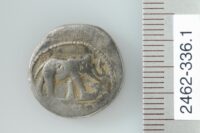 Archaeologists have discovered a large complex of stone walls from the early Roman Empire in the Äbnetwald gravel quarry in central Switzerland. This is the first time in nearly a century that the remains of a large Roman stone building has been found in the canton of Zug.
Archaeologists have discovered a large complex of stone walls from the early Roman Empire in the Äbnetwald gravel quarry in central Switzerland. This is the first time in nearly a century that the remains of a large Roman stone building has been found in the canton of Zug.
The first walls were discovered at the beginning of the year in an excavation of  the gravel mound near Cham-Oberwil. The gravel mound has been quarried since the 1990s and archaeologists have been investigating the newly-exposed top layer for potential findings since then. The archaeological team has now uncovered more than 5,000 square feet of a building complex with multiple rooms.
the gravel mound near Cham-Oberwil. The gravel mound has been quarried since the 1990s and archaeologists have been investigating the newly-exposed top layer for potential findings since then. The archaeological team has now uncovered more than 5,000 square feet of a building complex with multiple rooms.
 In addition to the architectural remains, archaeologists unearthed fragments of artifacts. Among them are pieces of utilitarian objects (bowls, millstones, workmanlike amphorae that held food staples like wine, olive and the infamous garum fish sauce) as well as more luxurious objects like imported terra sigillata dishware and blown glass vessels. There was also a single fragment of gold that likely was originally part of a piece of jewelry. These artifacts were not produced locally and thus bear witness to the reach of Roman trade networks.
In addition to the architectural remains, archaeologists unearthed fragments of artifacts. Among them are pieces of utilitarian objects (bowls, millstones, workmanlike amphorae that held food staples like wine, olive and the infamous garum fish sauce) as well as more luxurious objects like imported terra sigillata dishware and blown glass vessels. There was also a single fragment of gold that likely was originally part of a piece of jewelry. These artifacts were not produced locally and thus bear witness to the reach of Roman trade networks.
 The team also found bronze and copper coins, and one silver denarius struck by Julius Caesar in 49-48 B.C., shortly after he crossed the Rubicon and took Rome when Pompey, both consuls and much of Roman Senate fled the city. The coin has an elephant stepping on a horned serpent on the obverse and religious implements on the reverse. Caesar had his name stamped under the elephant. He struck what is now known as the “elephant denarius” with his military mint using silver from the treasury, obviously without approval of the Senate.
The team also found bronze and copper coins, and one silver denarius struck by Julius Caesar in 49-48 B.C., shortly after he crossed the Rubicon and took Rome when Pompey, both consuls and much of Roman Senate fled the city. The coin has an elephant stepping on a horned serpent on the obverse and religious implements on the reverse. Caesar had his name stamped under the elephant. He struck what is now known as the “elephant denarius” with his military mint using silver from the treasury, obviously without approval of the Senate.
It is unclear what the function of the building was. The remains of several villa rusticas (country estates) have been found before, and the presence of high-end terra sigillata and glass vessels suggests elite people visited or lived at the site.
“We were also amazed that the top bricks were even visible above ground”. Christa Ebnöther, Professor of Archeology of the Roman Provinces at the University of Bern, puts it this way: “Only a few structural relics of this kind from the Roman period are known in the pre-Alpine region – in contrast to other regions. What is also astounding is the relatively good preservation of the remains». The entire extent of the Roman buildings in the Äbnetwald is not yet known. […]
It is not surprising that the Romans chose the elevated position near Äbnetwald as the location for their buildings. It offered an excellent view and overview of the surrounding landscape, which served to supply water and food. The fact that the gravel hill near Oberwil was already inhabited several thousand years before the Romans came, testifies to the attractiveness of this location.